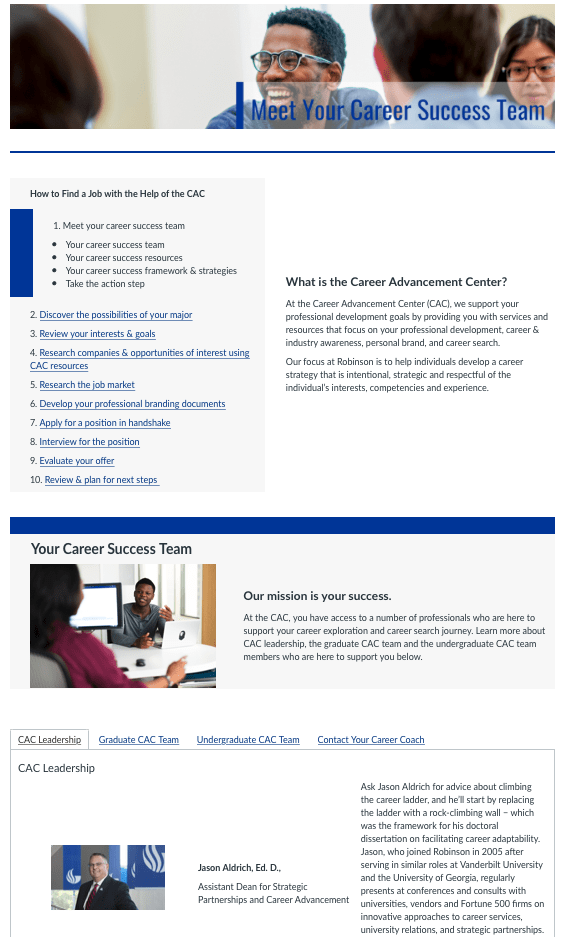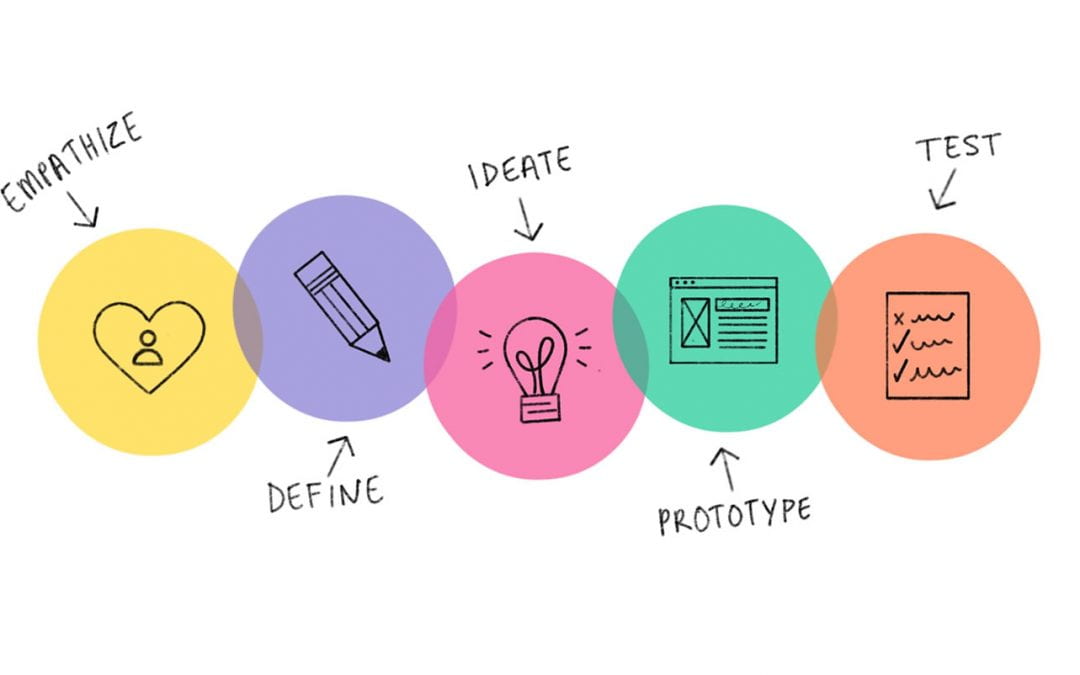Design Thinking is an interdisciplinary concept where designers bring innovative ideas and products to fruition by “[integrating] the needs of people, the possibilities of technology, and the requirements for success” (IDEO). This human-centered approach is the basis of what learning experience designers aim to achieve and, while it may appear as an abstract concept, those who aren’t trained designers can engage in this creative process to reimagine the possibilities of any learning experience.
The CAC’s Digital Career Toolbox
During the summer of 2021, I had the pleasure of working with the Career Advancement Center (CAC) in the Robinson College of Business (RCB) to redesign the Digital Career Toolbox, an online resource to support RCB students in developing their career success strategy. While the original toolbox featured fundamental information required for career success, the team at the CAC noticed an opportunity to develop the toolbox into a more student-driven, feedback-based, user-friendly resource.
By engaging in the 5 steps of the design thinking process (empathize, define, ideate, prototype and test), the team was able to design a learning experience driven by and designed for student career success.
Step 1: Empathize
Design Thinking Workshops
The empathize stage is defined by a period of reflection which propels teams to discuss fundamental challenges that impact the human experience. This can be achieved through design thinking workshops which create space for individuals to understand people, why they do what they do and how they can more effectively address specific challenges.

Source: Morgan Nixon
At the start of the project, the CAC design team engaged in a 4-part design thinking workshop series titled Principled Innovation, derived from Arizona State University. This experience allowed the team to rethink their goals and interactions with RCB students and envision how the toolbox itself could lead with human-centered principles and could more effectively shape students’ career journeys at GSU.
By engaging in workshops surrounding Principled Innovation, the CAC team was able to conceptualize the intersection of the team’s shared understanding of meaningful learning experiences and values, with the students’ needs, values and strategies toward meaning-making in order to create an updated toolbox that positively impacts students and society at large. Rather than simply reconfiguring the toolbox with technology and unique user interface features, we rebuilt the toolbox focusing on these humanistic values which would allow GSU students to become greater contributors to the professional world and the global society.
Student Focus Groups
Another way that we empathized with our users (or, RCB students) was holding student focus groups. The student voice was at the core of our design experience. After reaching out to students from the entire RCB, we interviewed 30 graduate and undergraduate students in a one-week time frame to gain feedback on the existing toolbox.
Step 2: Define
By empathizing with our target audience, we were more specifically able to define our problem and generate points in our redesign that more closely addressed the needs of our students. We more profoundly understood the following as key factors of our redesign:
- Relevance to students’ current stage in the career search
- Transparency form industry experts regarding the job search process
- Explicit action items toward building a solid career
- Greater connection with industry experts and peers
- Motivation to help GSU students’ identify themselves as global competitors
We triangulated these needs with the current Digital Career Toolbox and with educational research in how people learn and how students can transition from college to career. With this list of needs to address, the ideation stage commenced!
Step 3: Ideate
Wire-frames and Course Maps
In order to address the above student needs into an actual product, we amalgamated the goals of our redesigned toolbox, collected real-world examples of other online career courses for inspiration and wire-framed a number of course layouts to better incorporate our ideas into user-friendly pages using the learner management system (LMS), Canvas. We also mapped the module topics, content and action steps that students would take into an intricate course map for the team to reference.
Alas, we had a new direction based on student need– a now 7-module online resource where students could do the following:
- Select their current career stage on the homepage (Relevance)
- Watch an introductory video where alumni and employers discuss the skills needed at that specific career stage (Transparency & Greater Connection)
- Take specific actions featured on each module page toward achieving achieving success at their selected career stage (Explicit Action Item)
- Read quotes from current students and alumni about the career search (Motivation)
Step 4: Prototype

Source: Morgan Nixon
As we built the updated toolbox, we referred to this stage “prototype” to emphasize the iterative process of design. We first reviewed and updated the existing content and multimedia, we migrated the content from the existing toolbox to the updated layout, and we created videos in our CETLOE Multimedia Studio featuring alumni and employers to be featured in each module.
The final product was one-of-a-kind. In fact, this toolbox was the first that the CAC created to address the needs of students specifically via student feedback, yield alumni and employer contributions from the local community and foster a greater sense of community, trust and achievement all in one.
Step 5: Test
After just a few short weeks after the launch of the updated toolbox, one student notes: “These resources were excellent and I think I’ve a good idea on what I’ve to be prepared for.”
The toolbox is now in its first iteration where GSU students are self-enrolling in the resource. By engaging in the design process early on and understanding the needs of students and human interaction, the students are now engaging with materials that solve their challenges in the career search and that are just enough, just in time, and just for them.
Feedback from Partners
We’re proud of the feedback that we’ve gotten from CAC on this project and hope that this encourages other departments to reach out to CETLOE for all things teaching and learning:
“She did an outstanding job on our Digital Career Toolbox update project. We are thrilled with this innovative new resource.”
“She was great. She was super organized and that really helped our team get her the information that she needed to keep us on track. I hope to work with her again!”
“[This resource represents] a transformation of our content and the work [you] have done is AMAZING!”
Morgan Nixon is a Learning Experience Designer at CETLOE. In her free time, she provides emotional support to a needy beagle, pit-bull mix.



You must be logged in to post a comment.